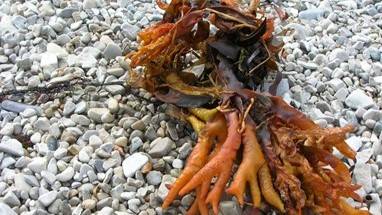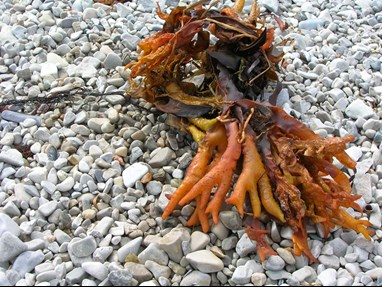Non-Living Plant Biostimulants: Can they benefit Your Crops? Part 2. Vitamins, Amino Acids and Seaweed


In the previous edition of the Growin Media Newsletter, we started a two part discussion on the use and importance of non-living plant biostimulants in greenhouse crop production. The first article focused on the use of humic substances, such as humic and fulvic acid, to potentially help with plant growth and health. Now in this second part, the discussion will focus on the use and benefits of vitamins, amino acids and seaweed in greenhouse crop production.
Vitamins
We not only need vitamins, but plants need vitamins too! Even though they are not essential for plant growth, they are used by plants to enhance metabolic functions. Vitamins are produced by fungi and bacteria found in the rhizosphere of plant roots and can be found in plant root exudates.
- Vitamin C: helps protect the plant against water stress, ozone and UV radiation. It is used in the photosynthetic process; it can regulate cell growth (Smirnoff and Weelet, 2000) and serves as a redox buffer. However, excess Vitamin C can have a negative impact on plant growth (Quian et al. 2014).
- Vitamin B1: is an antioxidant that helps protect plants from different environmental stresses like salinity (Sayed and Gadallah 2002). It can improve plant resistance against bacterial, fungal and viral infections (Ahn et al, 2005). It plays an important role in tissue culture media. There is a myth that Vitamin B1 stimulates root growth or reduces transplant shock, but there is no scientific evidence to prove that.
- Vitamin B2: is used for plant protection against diseases. It acts as an antioxidant and it promotes plant growth.
- Vitamin B6: creates resistance against plant diseases (Zhang et al, 2015) and it acts as an antioxidant.
- Vitamin E: researchers from the University of Toronto and Michigan State University found that Vitamin E helps with water and nutrient transport under cold conditions.
- Vitamin K: is an antioxidant that plays an important role in photosynthesis.
Amino Acids
Amino acids are organic compounds made of hydrogen, carbon, oxygen, nitrogen and sulfur. Only L-Amino acids are used by the plants. When combined, they make proteins; however, in the root rhizosphere, microorganisms break up proteins into amino acids which can be used by plants. Therefore, by maintaining a healthy microbial population in the rhizosphere, the roots will have an enormous opportunity to obtain amino acids.
Plants also make their own amino acids using nitrogen. These amino acids can also be used to protect plants from biotic and abiotic (low temperature, low relative humidity, salinity, pesticides, etc.) stresses or help them recover from these stresses. Amino acids have also been found to increase plant height and dry weight. In some cases amino acids have been found to increase nitrate uptake efficiency; but in other cases leaves exposed to amino acid applications have lower nitrate concentrations indicating there is an inhibition of nitrate uptake. Some amino acids combine with micronutrients forming chelates, to help plants obtain micronutrients in high pH soils.
Seaweed
Seaweed is another category of biostimulants that are sold as extracts that can be applied directly to the foliage. Seaweed extract is a mixture of organic components such as vitamins, fatty acids, low levels of plant nutrients and plant growth regulators (especially auxins, cytokinins and gibberellins). Plants treated with seaweed extracts have had increases in growth, earlier flowering, better yields (bigger fruits), improved protection from abiotic stresses (salinity, drought, low temperature) and enhanced photosynthesis. They also protect plants from insects like red spider mites and aphids as well as pathogenic nematodes, fungi and bacteria. When used as a soil conditioner, they can improve soil structure and water retention, resulting in a better environment for beneficial soil organisms.

In conclusion, biostimulants are not used to replace fertilizers. Biostimulants are to be used in conjunction with fertilizers to simply help plants grow and develop more efficiently by providing additional protection from biotic and abiotic stresses, improving fertilizer uptake and utilizing fertilizer elements more efficiently. Also, it is important to maintain a healthy root environment to promote the growth of beneficial microorganisms in the growing medium that produce biostimulants. This simple action can save money by minimizing the use of unwanted chemicals to treat unhealthy or diseased plants.
Non-Living Plant Biostimulants: Can they benefit Your Crops? Part 1. Humic Substances
References:
- Ahn IP, Kim S, Lee YH (2005) "Vitamin B1 functions as an activator of plant disease resistance." Plant Physiol 138: 1505–1515
- Quian, H. F., X. F. Peng, X. Han, J. Ren, K. Y. Zhan and M. Zhu. 2014. "The stress factor, exogenous ascorbic acid, affects plant growth and the antioxidant system in Arabidopsis thalian." Russian Journal of Plant Physiology. 61(4): 467-475.
- Sayed SA, Gadallah MAA (2002) "Effects of shoot and root application of thiamin on salt-stressed sunflower plants." Plant Growth Regul 36: 71–80
- Smirnoff, N. and G. L. Weeler. 2000. "Ascorbic acids in plants: biosynthesis and function. Critical reviews in biochemistry and moledular biology." 35(4): 291-314.
- Zhang, Y., X. Jin, Z. Ouyang, X. Li, B. Liu, L. Huang, Y. Hong, H. Zhang, F. Song and D. Li. 2015. "Vitamin B6 contributes to disease resistance against Pseudomonas syringae pv. tomato DC3000 and Botrytis cinerea in Arabidopsis thaliana."